Solar System
- The Solar System is the gravitationally bound system of the Sun and the objects that orbit it, either directly or indirectly.
- Our solar system consists of our star, the Sun, and everything bound to it by gravity – the planets Mercury, Venus, Earth, Mars, Jupiter, Saturn, Uranus, and Neptune; dwarf planets such as Pluto; dozens of moons; and millions of asteroids, comets, and meteoroids.
- The Solar System formed 4.6 billion years ago from the gravitational collapse of a giant interstellar molecular cloud.
Stars
- A star is an astronomical object comprising a luminous spheroid of plasma held together by its gravity.
- Stars are cosmic energy engines that produce heat, light, ultraviolet rays, x-rays, and other forms of radiation.
- Stars were formed when the galaxies were formed during the Big Bang.
- They are composed largely of gas and plasma, a superheated state of matter composed of subatomic particles.
- Stars are the fundamental building blocks of galaxies.
Moon
- The Moon is Earth’s only natural satellite.
- At about one-quarter the diameter of Earth, it is the fifth largest satellite in the Solar System, the largest satellite in the Solar System relative to its major planet, and larger than any known dwarf planet.
- Moon was formed 4.6 billion years ago around some 30–50 million years after the formation of the solar system
- It is in synchronous rotation with Earth meaning the same side is always facing the Earth.
- The Moon revolves around the Earth in 27 days 7 hours 43 minutes and 11.47 seconds and rotates on its own axis exactly the same time. That is why only one face of the Moon is seen from Earth.
- The total forces of the Moon and the Sun are in the ratio of 9: 4.
- Study of the Moon is known as Selenology.
Constellation
- Thousands of stars appear in the sky during the night. Some of these stars form a pattern in a group, which have recognizable shape. This group of stars is called constellation. At present there are about 88 constellations. Each constellation has been given a name according to its shape. Some of the important constellations are Ursa Major, Ursa Minor, Orion, Leo Major and Cassiopeia.
- Ursa Major: It is also known as Great Bear or Saptarishi. It consists of seven bright stars, which appear in the shape of a bear. It is visible during the summer season in the early part of the night and can be seen clearly during the month of April in the northern part of the sky. It also helps us to locate the position of the pole star in the sky. At night it appears to move from east to west as the pole star remains fixed in its position.
- Orion: This constellation is also known as hunter. The Indian name is Mriga. It consists of seven or eight bright stars. The orientation of stars in Orion is similar to the figure of hunter. This constellation is visible in the sky during the winter season in the late evening. One of the brightest stars in the sky at night is the Sinus, which is very close to the Orion constellation.
- Leo Major: This constellation mainly consists of 9 or 10 stars. Its orientation is similar to that of lion, hence its name is Leo. It is visible during the summer in the early part of night.
- Cassiopeia: It mainly consists of five stars, which are arranged in the form of letter W or M depending on its position in the sky. It is supposed to represent an ancient queen named Cassiopeia. It is visible during the winter in the early part of the night.
Planets
- A planet is a celestial body that
- (a) is in orbit around the Sun,
- (b) has sufficient mass for its self-gravity to overcome rigid body forces so that it assumes a hydrostatic equilibrium (nearly round) shape, and
- (c) has cleared the neighbourhood around its orbit.
- Planets: Mercury, Venus, Earth, Mars, Jupiter, Saturn, Uranus, Neptune
- A “dwarf planet” is a celestial body that
- (a) is in orbit around the Sun,
- (b) has sufficient mass for its self-gravity to overcome rigid body forces so that it assumes a hydrostatic equilibrium (nearly round) shape,
- (c) has not cleared the neighbourhood around its orbit, and (d) is not a satellite.
- Pluto now falls into the dwarf planet category on account of its size and the fact that it resides within a zone of other similarly sized objects known as the transneptunian region.
- All other objects, except satellites, orbiting the Sun shall be referred to collectively as “Small Solar System Bodies”.
- Planets with rings: Jupiter, Saturn, and Uranus have rings around them – belts of small debris
- Smallest planet: Mercury
- Largest planet: Jupiter
- Inner planets: Mercury, Venus, Earth, and Mars
- Outer planets: Jupiter, Saturn, Uranus and Neptune
Milky Way Galaxy
- A galaxy is defined as a large group of stars, gas, and dust bound together by gravity.
- Our galaxy is known as Milkyway because it appears as a milky band of light in the sky. Galaxies come in a variety of shapes and sizes. Milkway is a large barred spiral galaxy.
- In ancient India, it was imagined to be a river of light flowing in the sky. Thus, it was named Akash Ganga.
Sun
- It is a star made up of extremely hot gases, particularly by hydrogen (70%), Helium (26.5%), and others (3.5%) gases.
- It is 109 times bigger than the earth and weighs 2 × 1027 tonnes, and accounts for 99.83% of the mass of the solar system.
- It is 150 million km away from earth. The sunlight takes 8 minutes to reach the earth’s surface.
- It has immense gravitational pull which keeps the planets fixed in their orbit, revolving around the sun.
- It continuously gives off energy in the form of visible light, infra-red, ultraviolet, X- rays, gamma rays, radio waves, and plasma gas.
- The sudden flash of brightness observed near the sun’s surface which is a collection of magnetic energy including electrons, protons, and nuclei are called solar flares. They are concise particles and are harmful for satellite communication.
- The core of the sun consists of hydrogen atoms which fuse together due to compression and creates helium. This is called nuclear fusion.
- Nuclear fusion produces a huge amount of energy. It is radiated outward to the surface, atmosphere, and beyond.
- The convection zone is the next to the core of the sun. Here the temperature drops to 2-million-degree C.
- The photosphere’s temperature is 6,000°C.
- The atmosphere of the sun consists of the chromosphere and corona.
- Corona is seen in a form of spectral lines emitted by iron, calcium, and Nickle ions. The ionization of these elements increases the temperature of the corona.
- The solar flare (wind) is a stream of charged particles released from the upper atmosphere of the sun.
- These changed particles when get trapped by the earth’s magnetic field while entering the upper atmosphere of the earth result in the auroral (light) display.
- These auroral display in the northern hemisphere is called as Aurora Borealis (the Northern light) and when occurs in the southern hemisphere is called as Aurora Australis (the Southern lights).
- Sun-spots are dark appearing areas present in the photosphere from where solar flares originate. They are relatively a region cooler than its surrounding. It appears and disappears after every 11 years. This period is called the Sunspot Cycle.
- The cycle is marked by the increase and decrease of sunspots — visible as dark blemishes on the sun’s surface, or photosphere. The greatest number of Sunspots in any given solar cycle is designed as “solar maximum” and the lowest number is the “solar minimum“.

- The solar wind is a stream of charged particles released from the upper atmosphere of the Sun, called the corona. This plasma mostly consists of electrons, protons, and alpha particles with kinetic energy between 0.5 and 10 keV.
- A solar storm is a disturbance on the Sun, which can emanate outward across the heliosphere, affecting the entire Solar System, including Earth and its magnetosphere, and is the cause of space weather in the short-term with long-term patterns comprising space climate.
- A geomagnetic storm is a temporary disturbance of the Earth’s magnetosphere caused by a solar wind shock wave and/or cloud of a magnetic field that interacts with the Earth’s magnetic field.
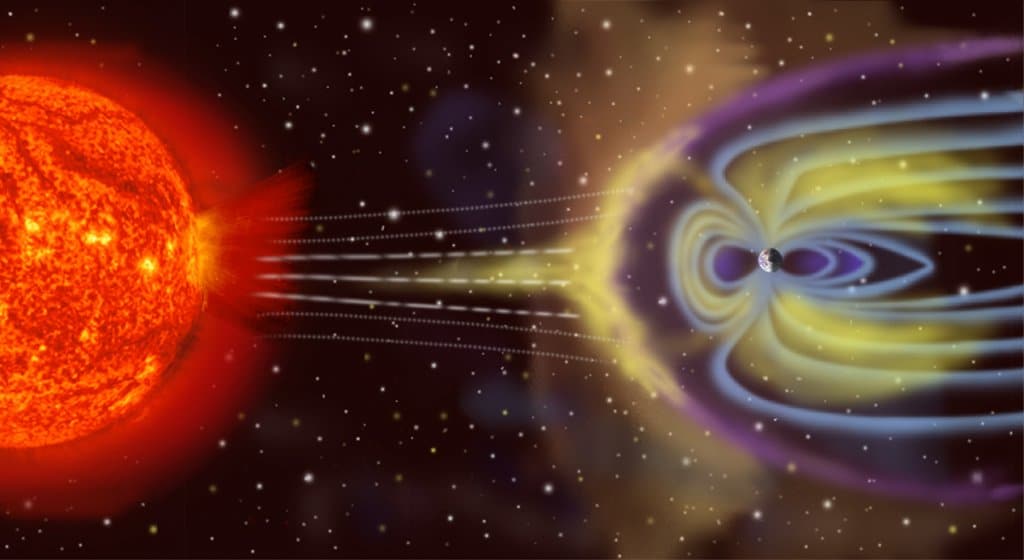
Earth
- Earth is the third planet from the sun at a distance of about 150 million km (93 million miles). That’s one Astronomical Unit (AU).
- A day on Earth is 24 hours (the time it takes the Earth to rotate or spin once).
- Earth’s atmosphere is 78% nitrogen (N2), 21% oxygen (O2) and 1% other ingredients – the perfect balance for living beings to breathe and live. Many planets in our solar system have atmospheres, but only Earth is breathable.
- Earth has one moon. Another name for a moon is a natural satellite.
- Earth is the perfect place for life as we know it.
- Our atmosphere protects us from incoming meteoroids, most of which break up in our atmosphere before they can strike the surface as meteorites.
Satellite
- Natural Satellite: A celestial body that moves around the planets in the same way as the planets move around the sun.
- Human-made Satellite: An artificial body designed by scientists to gather information about the universe or for communication. It is carried by rocket and placed in the orbit around the earth.
Asteroids
- Asteroids are minor planets especially those of the inner solar system.
- Asteroids orbit our sun in a region of space between the orbits of Mars and Jupiter known as the Asteroid Belt.
- Asteroids are solid, rocky and irregular bodies.
- Asteroids do not have atmospheres.
- More than 150 asteroids are known to have a small companion moon (some have two moons). The first discovery of an asteroid-moon system was of asteroid Ida and its moon Dactyl in 1993.
- Asteroids do not have rings.
- NASA space missions have flown by and observed asteroids. The Dawn mission is the first mission to orbit (2011) a main-belt asteroid (Vesta).
- Asteroids cannot support life.
- Ceres, the first and largest asteroid to be discovered (1801 by Giuseppe Piazzi), encompasses over one-third of the estimated total mass of all the asteroids in the asteroid belt.
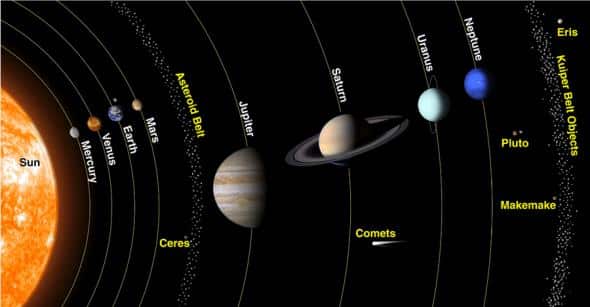
Meteors and Meteorites
While traveling through space, asteroids sometimes smash with each other & break up into minor remains. Comets shack dust as they wander the solar system. These ‘break ups’ result in frequent small particles & fragments, known as meteoroids, which orbit the sun.
Most meteoroids are rocky and small. When one draws near Earth, it burns up as it goes through the atmosphere of Earth. Thus a meteor is formed.
Fireballs are bigger meteoroids, approximately ranging in dimension anywhere from a basketball to a Volkswagen. They also make very imposing sky exhibits as they smash into fragments & burn up in their way through Earth’s atmosphere. Some meteoroids endure passage through the atmosphere of Earth & hit the ground. These are known as meteorites.
| Asteroid | Meteoroid |
| Asteroids are minor planets. | Meteorites are falling stars. |
| The orbital shape is elliptical and orbits the Sun | The orbital shape is elliptical and orbits the Sun but, get pulled into larger bodies. |
| Believed to be a leftover from the planet | Believed to be a smaller disintegrated element of comet or asteroid. |
| Do not have an atmosphere | Do not produce an atmosphere, but burn up when falling into a planet. |
| 1 to more than 100 kilometers in diameter | Typically, less than 10 meters. |
| Meteor | Meteorite |
| Meteors are still up in the sky. | Meteorites are on the earth. |
| Meteoroids break down in the earth’s atmosphere which results in the flash of light known meteors. | Meteorites are the broken meteoroids that land on the earth. |
Comets
Comets or ‘dirty snowballs’ are mostly made of dust, rocks, and ice and can range in their width from a few miles to tens of miles wide.
- When they orbit closer to the sun, like C/2020 F3, they heat up and release debris of dust and gases.
- The solid portions of comets consisting mostly of water, ice, and embedded dust particles are inactive when far away from the sun.
- When near the sun, the icy cometary surfaces vaporize and throw off large quantities of gas and dust thus forming the enormous atmosphere and tails.
- The released gases form a glowing head that can often be larger than a planet and the debris forms a tail that can stretch out to millions of miles.
- Each time a comet passes the sun, it loses some of its material and it will eventually disappear completely as a result.
- Comets may be occasionally pushed into orbits closer to the Sun and the Earth’s neighborhood due to forces of gravity.
- According to NASA, while there are millions of comets orbiting the sun, there are more than 3,650 known comets as of now.
- The predictable comets are the short-period comets that take less than 200 years to orbit around the sun.
- These can be found in the Kuiper belt, where many comets orbit the sun in the realm of Pluto.
- One of the most famous short-period comets is called Halley’s Comet that reappears every 76 years. Halley’s will be sighted next in 2062.
- The less-predictable comets can be found in the Oort cloud that is about 100,000 AU (Astronomical Unit which is the distance between the Earth and the Sun and is roughly 150 million km) from the sun or 100,000 times the distance between the Earth and the sun.
- Comets in this cloud can take as long as 30 million years to complete one rotation around the sun.
Visibility:
- Comets do not have the light of their own and the visibility depends on their gas and dust outbursts.
- Humans see the reflection of the sun’s light off the comet as well as the energy released by the gas molecules after it is absorbed from the sun.
- To be visible, a comet must make a particularly close approach to the sun to produce enormous quantities of gas and dust or it should make a relatively close approach to the Earth so that it is easily viewed.
Exoplanet
Exoplanets are the planets that orbit around other stars located outside our solar system. Exoplanets are also called extrasolar planets. All the stars have at least 1 planet revolving around them. Most of the exoplanets discovered so far are located in the Milky way galaxy.
They are also sometimes called “extrasolar planets“, “extra-” implying that they are outside of our solar system.
The Goldilocks Zone refers to the habitable zone around a star where the temperature is just right – not too hot and not too cold – for liquid water to exist on a planet.
- Our Earth is in the Sun’s Goldilocks zone. If Earth were where the dwarf planet Pluto is, all its water would freeze; on the other hand, if Earth were where Mercury is, all its water would boil off.
- Life on Earth started in water, and water is a necessary ingredient for life as we know it.
- So, when scientists search for the possibility of alien life, any rocky exoplanet in the habitable zone of its star is an exciting find.
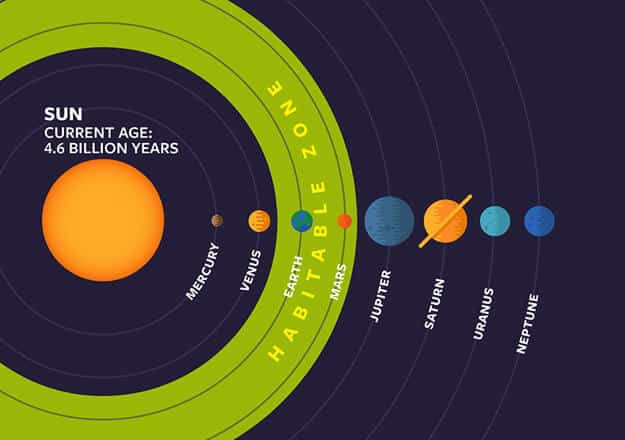
The TRAPPIST-1 planetary system sets a new record for the greatest number of habitable-zone planets found around a single star outside our solar system.
Sunspots
Sunspots (some as large as 50,000 km in diameter) are areas that appear dark on the surface of the Sun (photosphere). They appear dark because they are cooler than other parts of the Sun’s surface.
- However, the temperature of a sunspot is still very hot —around 6,500 degrees Fahrenheit.
- Photosphere is a visible surface of the Sun, from which is emitted most of the Sun’s light that reaches Earth directly.
They are relatively cool because they form at areas where magnetic fields are particularly strong. These magnetic fields are so strong that they keep some of the heat within the Sun from reaching the surface.
- Magnetic field in such areas is about 2,500 times stronger than Earth’s.
They typically consist of a dark region called the ‘umbra’, which is surrounded by a lighter region called the ‘penumbra’.
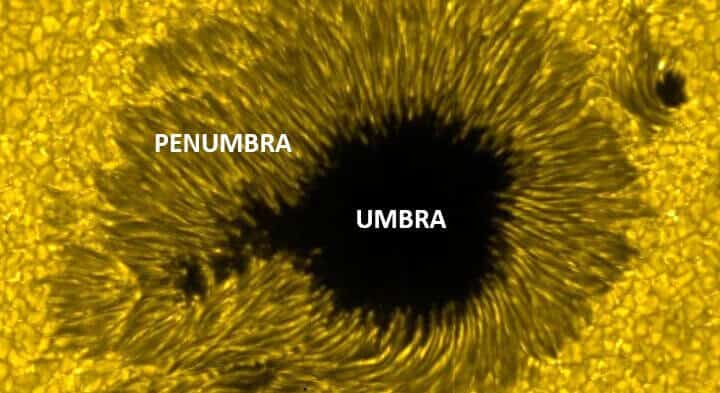
In every solar cycle, the number of Sunspots increases and decreases. The current solar cycle, which began in 2008, is in its ‘solar minimum’ phase, when the number of Sunspots and solar flares is at a routine low.
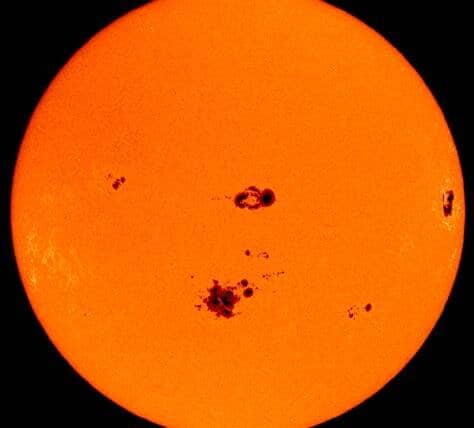
Solar Flares
- The magnetic field lines near sunspots often tangle, cross, and reorganize. This can cause a sudden explosion of energy called a solar flare.
- Solar flares release a lot of radiation into space. Solar flares, when powerful enough, can disrupt satellite and radio transmission on the Earth, and more severe ones can cause ‘geomagnetic storms’ that can damage transformers in power grids.
- A geomagnetic storm is a major disturbance of Earth’s magnetosphere that occurs when there is a very efficient exchange of energy from the solar wind into the space surrounding Earth.
- The magnetosphere is a region around the Earth dominated by the Earth’s magnetic field.
- It protects the Earth from solar and cosmic radiation as well as erosion of the atmosphere by the solar wind – the constant flow of charged particles streaming off the Sun.
- A geomagnetic storm is a major disturbance of Earth’s magnetosphere that occurs when there is a very efficient exchange of energy from the solar wind into the space surrounding Earth.
- Solar flares are sometimes accompanied by a Coronal Mass Ejection (CME).
- CMEs are huge bubbles of radiation and particles from the Sun’s Corona (outermost region of the Sun’s atmosphere). They explode into space at very high speed when the Sun’s magnetic field lines suddenly reorganize.
- They can trigger intense light in the sky on Earth, called auroras.
- Some of the energy and small particles travel down the magnetic field lines at the north and south poles into Earth’s atmosphere.
- There, the particles interact with gases in the atmosphere resulting in beautiful displays of light in the sky. Oxygen gives off the green and red light. Nitrogen glows blue and purple.
- The aurora in Earth’s northern atmosphere is called an aurora borealis or northern lights. Its southern counterpart is called an aurora australis or the southern lights.

Solar Cycle
- The Sun is a huge ball of electrically-charged hot gas. This charged gas moves, generating a powerful magnetic field. The Sun’s magnetic field goes through a cycle, called the solar cycle.
- Every 11 years or so, the Sun’s magnetic field completely flips. This means that the Sun’s north and south poles switch places. Then it takes about another 11 years for the Sun’s north and south poles to flip back again.
- The solar cycle affects activity on the surface of the Sun, such as sunspots which are caused by the Sun’s magnetic fields. As the magnetic fields change, so does the amount of activity on the Sun’s surface.
- One way to track the solar cycle is by counting the number of sunspots. The beginning of a solar cycle is a solar minimum, or when the Sun has the least sunspots. Over time, solar activity—and the number of sunspots—increases.
- The middle of the solar cycle is the solar maximum, or when the Sun has the most sunspots. As the cycle ends, it fades back to the solar minimum and then a new cycle begins.



